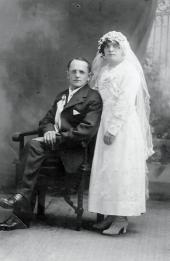
The “Spanish Flu” was named in May 1918, since the Spanish media was the first to document the pandemic during a period in World War I when most countries had strict censorship. The Spanish Flu was an extreme strain of the influenza virus, which was transmitted by inhaling infected air. Scientists have hypothesized that this virus originated in China as a strain of avian influenza, which mutated and infected herds of swine. This virus was contracted by humans, and was dispersed throughout society as people and goods moved along Asian-European trade routes. In the trenches of World War I, the Spanish Flu quickly spread. Infected soldiers began returning to their homelands, thus carrying the virus throughout the world.
Symptoms, such as chills, fever, headaches, pains, weakness, coughing up blood, and delirium, appeared suddenly. It was not uncommon for a person to be healthy in the morning, yet die from the virus by the evening. Two effects of the Spanish Flu were the increased risks of contracting a respiratory infection such as pneumonia, or becoming inflicted with cyanosis, a bluish skin discoloration that resulted from severely diminished amounts of haemoglobin in the blood. The Spanish Flu was difficult to treat because medical understanding of viral infections did not occur until the 1930s. Just as with today’s influenza, there was no cure for the Spanish Flu. The most popular remedies were bed rest or drinking alcohol. Because of prohibition in Saskatchewan, alcohol could only be obtained with a doctor’s prescription from one of two distributing pharmacies in the province. Other preventative measures to which people resorted were folk remedies or wearing of masks.
The infection rate of the virus in Saskatchewan was about one in every four families. This virus was most detrimental to the 20 to 40 years age group, where the survival rate was 50%. As the epidemic spread through out the province, a shortage of doctors was apparent. Approximately 10% of doctors were on military service, while many others became sick or died themselves due to the virus. Furthermore, 87% of the population lived in rural areas, yet had access to only a third of the province’s hospital beds. Most deaths from this epidemic occurred at home. Often, bodies were stacked upon one another while undertakers waited for coffins. Once coffins were available, burial permits were often overlooked in order for the bodies to be quickly laid to rest. The Transportation of dead bodies was not permitted, in order to control the spread of the virus. Communities were quarantined, schools were closed, church services cancelled, and public meetings were banned. Because of the impact of the virus on the 20 to 40 years age group, many Children were left orphaned by this epidemic.
The Spanish Flu gradually weakened in 1919, and by 1920 had run its course. It has been estimated that the total deaths worldwide from this epidemic reached upwards of 20 million. In Canada, 50,000 people died, including 5,000 in Saskatchewan. As a result of this epidemic, there were demands for an increase in the number of Hospitals throughout the province, an increase in doctor’s salaries, and more training on caring for the sick at home.
Erin Legg
Print EntryLux, Maureen. 1997. “The Bitter Flats: The 1918 Influenza Epidemic in Saskatchewan,” Saskatchewan History 29 (1).
HOME | BROWSE BY SUBJECT | ENTRY LIST (A-Z) | IMAGE INDEX | CONTRIBUTOR INDEX | ABOUT THE ENCYCLOPEDIA | SPONSORS TERMS OF USE | COPYRIGHT © 2006 CANADIAN PLAINS RESEARCH CENTER, UNIVERSITY OF REGINA | POWERED BY MERCURY CMS |
|||
| This web site was produced with financial assistance provided by Western Economic Diversification Canada and the Government of Saskatchewan. |
|||
 |
 |
 |
 |
| Ce site Web a été conçu grâce à l'aide financière de Diversification de l'économie de l'Ouest Canada et le gouvernement de la Saskatchewan. |
|||